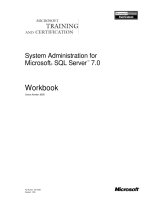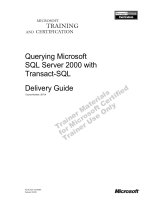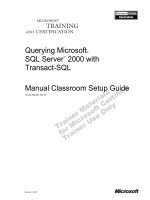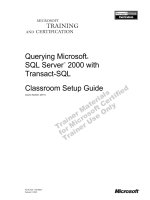microsoft sql server alwayson solutions guide for high availability and disaster recovery
Bạn đang xem bản rút gọn của tài liệu. Xem và tải ngay bản đầy đủ của tài liệu tại đây (1.19 MB, 33 trang )
Mi
c
Sol
Av
a
LeRo
y
Contri
b
Mishra
Revie
w
(SQLH
A
Matth
e
Thoma
Summa
maximi
z
Always
O
A key g
o
betwee
n
infrastr
u
Catego
r
Applies
Source:
E-book
32 page
c
ros
o
utio
n
a
ilab
y
Tuttle
,
b
utors: L
i
w
ers: Kevi
A
), Alexei
e
ws, Ayad
S
s, Benja
m
ry: This wh
z
e applicati
o
O
n high ava
o
al of this
p
n
business
s
u
cture engi
n
r
y: Quick G
to: SQL S
e
White pap
publicati
o
s
o
ft S
Q
n
s G
u
ility
a
,
Jr.
i
ndsey All
n Farlee,
S
Khalyako
,
S
hammo
u
m
in Wrigh
t
ite paper d
o
n availabil
ilability an
d
p
aper is to
e
s
takeholde
r
n
eers, and
d
uide
e
rver 2012
er (link to
s
o
n date: M
a
Q
L S
e
u
ide
a
nd
en, Justin
S
hahryar
G
,
Wolfgan
u
t (Careg
r
t
-Jones
iscusses h
o
ity, and pr
o
d
disaster r
e
e
stablish a
r
s, technica
d
atabase a
d
s
ource cont
a
y 2012
e
rve
r
for
H
Disa
s
Erickson,
G
. Hashe
m
g Kutsch
e
r
oup), Da
v
o
w to redu
c
o
vide data
p
e
covery sol
common c
o
l decision
m
d
ministrat
o
ent)
r
Al
w
H
igh
s
ter
Min He,
C
m
i (Motri
c
e
ra (Bwin
v
id P. Smi
t
c
e planned
p
rotection
utions.
o
ntext for
r
m
akers, sys
t
o
rs.
w
ays
O
Rec
o
C
ephas Li
c
ity), Alla
n
Party), C
h
t
h (Servic
e
and unpla
n
using SQL
S
r
elated disc
t
em archit
e
O
n
o
ver
y
n, Sanjay
n
Hirt
h
arles
e
U), Juer
g
n
ned down
t
S
erver 201
2
ussions
e
cts,
y
g
en
t
ime,
2
This page intentionally left blank
Copyright © 2012 by Microsoft Corporation
All rights reserved. No part of the contents of this book may be reproduced or transmitted in any form or by any means
without the written permission of the publisher.
Microsoft and the trademarks listed at
are trademarks of the
Microsoft group of companies. All other marks are property of their respective owners.
The example companies, organizations, products, domain names, email addresses, logos, people, places, and events
depicted herein are fictitious. No association with any real company, organization, product, domain name, email address,
logo, person, place, or event is intended or should be inferred.
This book expresses the author’s views and opinions. The information contained in this book is provided without any
express, statutory, or implied warranties. Neither the authors, Microsoft Corporation, nor its resellers, or distributors will
be held liable for any damages caused or alleged to be caused either directly or indirectly by this book.
MicrosoftSQLServerAlwaysOnSolutionsGuideforHighAvailabilityandDisasterRecovery iv
Contents
HighAvailabilityandDisasterRecoveryConcepts
1
DescribingHighAvailability 1
Plannedvs.UnplannedDowntime 1
DegradedAvailability 2
QuantifyingDowntime 2
RecoveryObjectives 3
JustifyingROIorOpportunityCost 3
MonitoringAvailabilityHealth 4
PlanningforDisasterRecovery 4
Overview:HighAvailabilitywithMicrosoftSQLServer2012 5
SQLServerAlwaysOn 5
SignificantlyReducePlannedDowntime 5
EliminateIdleHardwareandImproveCostEfficiencyandPerformance 6
EasyDeploymentandManagement 6
ContrastingRPOandRTOCapabilities 6
SQLServerAlwaysOnLayersofProtection 7
InfrastructureAvailability 8
WindowsOperatingSystem 8
WindowsServerFailoverClustering 9
WSFCClusterValidationWizard 11
WSFCQuorumModesandVotingConfiguration 12
WSFCDisasterRecoverythroughForcedQuorum 15
SQLServerInstanceLevelProtection 17
AvailabilityImprovements–SQLServerInstances 17
AlwaysOnFailoverClusterInstances 18
DatabaseAvailability 21
AlwaysOnAvailabilityGroups 21
AvailabilityGroupFailover 22
AvailabilityGroupListener 24
AvailabilityImprovements–Databases 26
ClientConnectivityRecommendations 27
Conclusion 28
MicrosoftSQLServerAlwaysOnSolutionsGuideforHighAvailabilityandDisasterRecovery 1
HighAvailabilityandDisasterRecoveryConcepts
Youcanmakethebestselectionofadatabasetechnologyforahighavailabilityanddisasterrecovery
solutionwhenallstakeholdershaveasharedunderstandingoftherelatedbusinessdrivers,challenges,
andobjectivesofplanning,managing,andmeasuringRTOandRPOobjectives.
Readerswhoarefamiliarwiththeseconceptscanmove
aheadtotheOverview:HighAvailabilitywith
MicrosoftSQLServer2012sectionofthispaper.
DescribingHighAvailability
Foragivensoftwareapplicationorservice,highavailabilityisultimatelymeasuredintermsofthe
enduser’sexperienceandexpectations.Thetangibleandperceivedbusinessimpactofdowntimemay
beexpressedintermsofinformationloss,propertydamage,decreasedproductivity,opportunitycosts,
contractualdamages,orthelossofgoodwill.
Theprincipalgoalof
ahighavailabilitysolution istominimizeormitigatetheimpactofdowntime.A
soundstrategyforthisoptimallybalancesbusinessprocessesandServiceLevelAgreements(SLAs)with
technicalcapabilitiesandinfrastructurecosts.
Aplatformisconsideredhighlyavailablepertheagreementandexpectationsofcustomersand
stakeholders.Theavailabilityofa
systemcanbeexpressedasthiscalculation:
100%
Theresultingvalueisoftenexpressedbyindustryintermsofthenumberof9’sthatthesolution
provides;meanttoconveyanannualnumberofminutesofpossibleuptime,orconversely,minutesof
downtime.
Numberof9’s AvailabilityPercentage TotalAnnualDowntime
2 99% 3days,15hours
3 99.9% 8hours,45minutes
4 99.99% 52minutes,34seconds
5 99.999% 5minutes,15seconds
Plannedvs.UnplannedDowntime
Systemoutagesareeitheranticipatedandplannedfor,ortheyaretheresultofanunplanned
failure.Downtimeneednotbeconsider ed negativelyifitisappropriatelymanaged.Therearetwokey
typesofforeseeabledowntime:
Plannedmaintenance.Atimewindowispreannouncedandcoordinatedforpla nned
maintenance
taskssuchassoftwarepatching,hardwareupgrades,passwordupdates,offlinere‐indexing,data
loading,ortherehearsalofdisasterrecoveryprocedures.Deliberate,well‐managedoperational
proceduresshouldminimizedowntimeandpreventanydataloss.Plannedmaintenanceactivities
MicrosoftSQLServerAlwaysOnSolutionsGuideforHighAvailabilityandDisasterRecovery 2
canbeseenasinvestmentsneededtopreventormitigateotherpotentiallymoresevereunplanned
outagescenarios.
Unplannedoutage.System‐level,infrastructure,orprocess failuresmayoccur thatareunplannedor
uncontrollable,orthatareforeseeable,butconsideredeithertoounlikelytooccur,orare
consideredtohaveanacceptable
impact.Arobusthighavailabilitysolutiondetectsthesetypesof
failures,automaticallyrecoversfromtheoutage,andthenreestablishes faulttolerance.
WhenestablishingSLAsforhighavailability,yousho uldcalculateseparatekeyperformance
indicators(KPIs)forplannedmaintenanceactivitiesandunplanneddowntim e.Thisapproachallowsyou
tocontrastyourinvestmentinplanned
maintenanceactivitiesagainstthebenefitofavoidingunplanned
downtime.
DegradedAvailability
Highavailabilityshouldnotbeconsideredasanall‐or‐nothingproposition.Asanalternativetoa
completeoutage,itisoftenacceptabletotheenduserforasystemtobeparti allyavailable,ortohave
limitedfunctionalityordegradedperformance.These
varyingdegreesofavailabilityinclude:
Read‐onlyanddeferredoperations.Duringamaintenancewindow,orduringaphaseddisaster
recovery,dataretrievalisstillpossible,butnewworkflowsandbackgroundprocessingmaybe
temporarilyhaltedorqueued.
Datalatencyandapplicationresponsiv eness.Duetoaheavyworkload,aprocessing
backlog,ora
partialplatformfailure,limitedhardwareresourcesmaybeover‐committedorunder‐sized.User
experiencemaysuffer,butworkmaystillgetdoneinalessproductivemanner.
Partial,transient,orimpendingfailures.Robustnessintheapplicationlogicorhardwarestackthat
retriesorself‐correctsuponencountering
anerror.Thesetypesofissuesmayappeartotheenduser
asdatalatencyorpoorapplicationresponsiveness.
Partialend‐to‐endfailure.Plannedorunplannedoutagesmayoccurgracefullywithinverticallayers
ofthesolutionstack(infrastructure,platform,andapplication),orhorizontallybetweendifferent
functionalcomponents.Usersmayexperiencepartia l
successordegradation,dependinguponthe
featuresorcomponentsthatareaffected.
Theacceptabilityofthesesuboptimal scenarios shouldbeconsideredaspartofaspectrumofdegraded
availabilityleadinguptoacompleteoutage,andasintermediatestepsinaphaseddisasterrecovery.
QuantifyingDowntime
Whendowntimedoesoccur,eitherplanned,orunplanned,theprimarybusinessgoalistobringthe
systembackonlineandminimizedataloss.Everyminuteofdowntimehasdirectandindirectcosts.With
unplanneddowntime,youmustbalancethetimeandeffortneededtodeterminewhytheoutage
occurred,whatthecurrentsystem
stateis,andwhatstepsareneededtorecoverfromtheoutage.
MicrosoftSQLServerAlwaysOnSolutionsGuideforHighAvailabilityandDisasterRecovery 3
Atapredeterminedpointinanyoutage,youshouldmakeorseekthebusinessdecisiontostop
investigatingtheoutageorperformingmaintenancetasks,recoverfromtheoutagebybringingthe
systembackonline,andifneeded,reestablishfaulttolerance.
RecoveryObjectives
Dataredundancyisakeycomponentofa
highavailabilitydatabasesolution.Transactionalactivityon
yourprimarySQLServerinstanceissynchronouslyorasynchronouslyappliedtooneormoresecondary
instances.Whenanoutageoccurs,transactionsthatwereinflightmayberolledback,ortheymaybe
lostonthesecondaryinstancesduetodelaysindatapropagation.
You
canbothmeasuretheimpact,andsetrecoverygoalsintermshowlongittakestogetbackin
business,andhowmuchtimelatencythereisinthelasttransactionrecovered:
RecoveryTimeObjective(RTO).Thisisthedurationoftheoutage.Theinitialgo alis togetthe
system
backonlineinatleastaread‐onlycapacitytofacilitateinvestigationofthefailure.However,
theprimarygoalistorestorefullservicetothepoint thatnewtransactionscantakeplace.
RecoveryPointObjective(RPO).Thisisoftenreferredtoasameasureofacceptabledataloss.Itis
thetimegaporlatencybe tweenthelastcommitteddatatransactionbeforethefailureandthe
mostrecentdatarecoveredafterthefailure.Theactualdatalosscanvarydependinguponthe
workloadonthesystematthetimeofthefailure,thetypeoffailure,andthetypeof
high
availabilitysolutionused.
YoushoulduseRTOandRPOvaluesasgoalsthatindicatebusinesstolerancefordowntimeand
acceptabledataloss,andasmetricsformonitoringavailabilityhealth.
JustifyingROIorOpportunityCost
Thebusinesscostsofdowntimemaybeeitherfinancialorintheformofcustomergoodwill.Thesecosts
mayaccruewithtime,ortheymaybeincurredatacertainpointintheoutagewindow.Inadditionto
projectingthecostofincurringanoutagewithagivenrecoverytimeanddatarecoverypoint,youcan
alsocalculatethebusinessprocessandinfrastructureinvestmentsneededtoattainyourRTO
andRPO
goalsortoavoidtheoutagealltogether.Theseinvestmentthemesshouldinclude:
Avoidingdowntime.Outagerecoverycostsareavoidedalltogetherifanoutagedoesn’toccurinthe
firstplace.Investmentsincludethecostoffault‐tolerantandredundanthardwareorinfrastructure,
distributingworkloadsacrossisolatedpointsoffailure,and
planneddowntimeforpreventive
maintenance.
Automatingrecovery.Ifasystemfailureoccurs,youcangreatlymitigatetheimpactofdowntimeon
thecustomerexperiencethroughautomaticandtransparentrecovery.
Resourceutilization.Secondaryorstandbyinfrastructurecansit idle,awaitinganoutage.Italsocan
beleveragedforread‐onlyworkloads,or
toimproveoverallsystemperformancebydistributing
workloadsacrossallavailablehardware.
MicrosoftSQLServerAlwaysOnSolutionsGuideforHighAvailabilityandDisasterRecovery 4
ForgivenRTOandRPOgoals,theneededavailabilityandrecoveryinvestments,combinedwiththe
projectedcostsofdowntime,canbeexpressedandjustifiedasafunctionoftime.Duringanactual
outage,thisallowsyoutomakecost‐baseddecisionsbasedontheelapseddowntime.
MonitoringAvailabilityHealth
Froman
operationalpointofview,duringanactualoutage,youshouldnotattempttoconsiderall
relevantvariablesandcalculateROIoropportunitycostsinrealtime.Instead,youshouldmonitordata
latencyonyourstandbyinstancesasaproxyforexpectedRPO.
Intheeventofanoutage,youshouldalsolimit
theinitialtimespentinvestigatingtherootcauseduring
theoutage,andinsteadfocusonvalidatingthehealthofyourrecoveryenvironment,andthenrelyupon
detailedsystemlogsandsecondarycopiesofdataforsubsequentforensicanalysis.
PlanningforDisasterRecovery
Whilehighavailabilityeffortsentailwhatyoudo
topreventanoutage,disasterrecoveryeffortsaddress
whatisdonetore‐establishhighavailabilityaftertheoutage.
Asmuchaspossible,disasterrecoveryproceduresandresponsibilitiesshouldbeformulatedbeforean
actualoutageoccurs.Baseduponactivemonitoringandalerts,thedecisiontoinitiateanautomatedor
manualfailoverand
recoveryplanshouldbetiedtopre‐establishedRTOandRPOthresholds.Thescope
ofasounddisasterrecoveryplanshouldinclude:
Granularityoffailureandrecovery.Dependinguponthelocationandtypeoffailure,youcantake
correctiveactionatdifferentlevels;thatis,datacenter,infrastructure,platform,application,or
workload.
Investigativesourcematerial.Baselineandrecentmonitoringhistory,systemalerts,eventlogs,and
diagnosticqueriesshouldallbereadilyaccessiblebyappropriateparties.
Coordinationofdependencies.Withintheapplicationstack,andacrossstakeholders,whatarethe
systemandbusinessdependencies?
Decisiontree.Apredetermined, repeatable,validateddecisiontreethat
includesrole
responsibilities,faulttriage,failovercriteriaintermsofRPOandRTOgoals,andprescribedrecovery
steps.
Validation.Aftertakingstepstorecoverfromtheoutage,whatmustbedonetoverifythatthe
systemhasreturnedtonormaloperations?
Documentation.Captur ealloftheaboveitemsin
asetofdocumentation,withsufficientdetailand
claritysothatathirdpartyteamcanexecutetherecoveryplanwithminimalassistance.Thistype
ofdocumentationiscommonlyreferredasa‘runbook’ora‘cookbook’.
Recoveryrehearsals.Regularlyexercisethedisasterrecoveryplantoestablishbaselineexpectations
forRTOgoals,andconsiderregularrotationofhostingtheprimaryproductionsiteontheprimary
andeachofthedisasterrecoverysites.
MicrosoftSQLServerAlwaysOnSolutionsGuideforHighAvailabilityandDisasterRecovery 5
Overview:HighAvailabilitywithMicrosoftSQLServer2012
AchievingtherequiredRPOandRTOgoalsinvolvesensuringcontinuousuptimeofcriticalapplications
andprotectionofcriticaldatafromunplannedandplanneddowntime.SQLServerprovidesasetof
featuresandcapabilitiesthatcanhelpachievethosegoalswhilekeepingthecostandcomplexitylow.
Readerswhohaveahigh‐levelfamiliarity
withthenewAlwaysOncapabilitiescanmoveaheadtothe
deepercoverageintheSQLServerAlwaysOnLayersofProtection
sectionofthispaper.
SQLServerAlwaysOn
AlwaysOnisanewintegrated,flexible,cost‐efficienthighavailabilityanddisasterrecoverysolution.It
canprovidedataandhardwareredundancywithinandacrossdatacenters,andimprovesapplication
failovertimetoincreasetheavailabilityofyourmission‐criticalapplications.AlwaysOnprovidesflexibility
inconfigurationandenablesreuse
ofexistinghardwareinvestments.
AnAlwaysOnsolutioncanleveragetwomajorSQLServer2012featuresforconfiguringavailabilityat
boththedatabaseandtheinstancelevel:
AlwaysOnAvailabilityGroups,newinSQLServer2012,greatlyenhancethecapabilitiesofdatabase
mirroringandhelpsensureavailabilityofapplicationdatabases,and
theyenablezerodataloss
throughlog‐baseddatamovementfordataprotectionwithoutshareddisks.
Availabilitygroupsprovideanintegratedsetofoptionsincludingautomaticandmanualfailoverofa
logicalgroupofdatabases,supportforuptofoursecondaryreplicas,fastapplicationfailover,and
automaticpagerepair.
AlwaysOnFailoverClusterInstances(FCIs)enhancetheSQLServerfailoverclusteringfeatureand
supportmultisiteclusteringacrosssubnets,whichenablescross‐data‐centerfailoverofSQLServer
instances.Fasterandmorepredictableinstancefailoverisanotherkeybenefitthatenablesfaster
applicationrecovery.
SignificantlyReducePlannedDowntime
Thekeyreasonfor
applicationdowntimeinanyorganizationisplanneddowntimecausedbyoperating
systempatching,hardwaremaintenance,andsoon.Thiscanconstitutealmost80percentofthe
outagesinanITenvironment.
SQLServer2012helpsreduceplanneddowntimesignificantlybyreducingpatchingrequirementsand
enablingmoreonlinemaintenanceoperations:
WindowsServerCore.SQLServer2012supportsdeploymentsonWindowsServ er Core,aminimal,
streamlineddeploymentoptionforWindowsServer2008andWi ndows Server2008R2.This
operatingsystemconfigurationcanreduceplann eddowntimebyminimizingoperatingsystem
patchingrequirementsbyasmuchas60percent.
OnlineOperations.Enhancedsupportfor
onlineoperationslikeLOBre‐indexingandaddingcolumns
withdefaultvalueshelpstoreducedowntimeduringdatabasemaintenanceoperations.
MicrosoftSQLServerAlwaysOnSolutionsGuideforHighAvailabilityandDisasterRecovery 6
RollingUpgradeandPatching.AlwaysOnfeaturesfacilitaterollingupgradesandpatchingof
instances,whichhelpssignificantlytoreduceapplicationdowntime.
SQLServeronHyper‐V.SQLServerinstanceshostedintheHyper‐Venvironme ntreceive the
additionalbenefitofLiveMigration,whichenablesyoutomigratevirtualmachinesbetween
hosts
withzerodowntime.Administratorscanperformmaintenanceoperationsonthehostwithout
impactingapplications.
EliminateIdleHardwareandImproveCostEfficiencyandPerformance
Typicalhighavailabilitysolutionsinvolvedeploymentofcostly,redundant,passiveservers.AlwaysOn
AvailabilityGroupsenableyoutoutilizesecondaryda tabasereplicasonotherwisepassiveoridleservers
for
read‐onlyworkloadssuchasSQLServerReportingServicesreportqueriesorbackupoperations.The
abilitytosimultaneouslyutilizeboththeprimaryandsecondarydatabasereplicashelpsimprove
performanceofallworkloadsduetobetterresourcebalancingacrossyourserverhardware
investments.
EasyDeploymentandManagement
FeaturessuchastheConfiguration
Wizard,supportfortheWindowsPowerShellcommand‐line
interface,dashboards,dynamicmanagementviews(DMVs),policy‐basedmanagement,andSystem
Centerintegrationhelpsimplifyde ploymentandmanagementofavailabilitygroups.
ContrastingRPOandRTOCapabilities
ThebusinessgoalsforRecoveryPointObjective(RPO)andRecoveryTimeObjective(RTO)shouldbekey
driversinselecting
aSQLServertechnologyforyourhighavailabilityanddisasterrecoverysolution.
Thistableoffersaroughcomparisonofthetypeofresultsthatthosedifferentsolutionsmayachieve:
HighAvailabilityandDisasterRecovery
SQLServerSolution
Potential
DataLoss
(RPO)
Potential
Recovery
Time(RTO)
Automatic
Failover
Readable
Secondaries
(1)
AlwaysOnAvailabilityGroup‐synchronous‐commit
Zero Seconds Yes
(
4
)
0‐2
AlwaysOnAvailabilityGroup‐asynchronous‐commit
Seconds Minutes No 0‐4
AlwaysOnFailoverClusterInstance
NA
(
5
)
Seconds
‐to‐minutes
Yes NA
DatabaseMirroring
(2)
‐High‐safety(sync+witness)
Zero Seconds Yes NA
DatabaseMirroring
(2)
‐High‐performance(async)
Seconds
(
6
)
Minutes
(
6
)
No NA
LogShipping
Minutes
(
6
)
Minutes
‐to‐hours
(6)
No Notduring
arestore
Backup,Copy,Restore
(3)
Hours
(
6
)
Hours
‐to‐days
(6)
No Notduring
arestore
(1)
AnAlwaysOnAvailabilityGroupcanhavenomorethanatotaloffoursecondaryreplicas,regardlessoftype.
(2)
ThisfeaturewillberemovedinafutureversionofMicrosoftSQLServer.UseAlways OnAvailabilityGroupsinstead.
(3)
Backup,Copy,Restoreisappropriatefordisasterrecovery,butnotforhighavailability.
(4)
Automaticfailoverofanavailabilitygroupisnotsupportedtoorfromafailoverclusterinstance.
(5)
TheFCIitselfdoesn’tprovidedataprotection;datalossisdependentuponthestoragesystemimplementation.
(6)
Highlydependentupontheworkload,datavolume,andfailoverprocedures.
MicrosoftSQLServerAlwaysOnSolutionsGuideforHighAvailabilityandDisasterRecovery 7
SQLServerAlwaysOnLayersofProtection
SQLServerAlwaysOnsolutionshelpprovidefaulttoleranceanddisasterrecoveryacrossseverallogical
andphysicallayersofinfrastructureandapplicationcomponents.Historically,ithasbeenacommon
practicetohaveaseparationofdutiesandresponsibilitiesforthevariousinvolvedaudiencesandroles,
suchthateachwaspredominatelyonlyconcerned
aportionofthosesolutionlayers.
Thissectionofthepaperisorganizedtowalkthroughadeeperdescriptionofeachofthoselayers,and
toofferrationaleandguidanceforyourdesigndiscussionsandimplementationdecisions.
AsuccessfulSQLServerAlwaysOnsolutionrequiresunderstandingandcollaborationacrosstheselayers:
Infrastructurelevel.Server‐levelfault‐toleranceandintra‐nodenetworkcommunicationleverages
WindowsServerFailover Clustering(WSFC)featuresforhealthmonitoringandfailovercoordination.
SQLServerinstancelevel.ASQLServerAlwaysOnFailoverClusterInstance(FCI)isaSQLServer
instancethatisinstalledacrossandcanfailovertoserver
nodesinaWSFCcluster.Thenodesthat
hosttheFCIareattachedtorobustsymmetricsharedstorage(SANorSMB).
Databaselevel.Anavai labilitygroupisasetofuserdatabases that failovertogether.Anavailability
groupconsistsofaprimaryreplicaandonetofoursecondaryreplicas.Eachreplica
ishostedbyan
instanceofSQLServer(FCIornon‐FCI)onadifferentnodeoftheWSFCcluster.
Clientconnectivity.DatabaseclientapplicationscanconnectdirectlytoaSQLServerinstance
networkname,ortheymayconnecttoavirtualnetworkname(VNN)thatisboundtoan
availability
grouplistener.TheVNNabstractstheWSFCclusterandavailabilitygrouptopology,
logicallyredirectingconnectionrequeststotheappropriateSQLServerinstanceanddatabasereplica.
ThelogicaltopologyofarepresentativeAlwaysOnsolutionisillustratedinthisdiagram:
MicrosoftSQLServerAlwaysOnSolutionsGuideforHighAvailabilityandDisasterRecovery 8
InfrastructureAvailability
BothAlwaysOnAvailabilityGroupsandAlwaysOnFailoverClusterInstancesleveragetheWindows
ServeroperatingsystemandWSFCasaplatformtechnology.Morethaneverbefore,successful
MicrosoftSQLServerdatabaseadministratorswillrelyuponasolidunderstandingofthesetechnologies.
WindowsOperatingSystem
SQLServerreliesupontheWindowsplatformto
providefoundationalinfrastructureandservicesfor
networking,storage,security,patching,andmonitoring.
ThedifferenteditionsofSQLServer2012progressivelybuildupontheincreasingcapabilitiesand
capacityofsimilareditionsoftheWindowsServer2008R2operatingsystem,includingWindowsServer
2008R2Standardoperatingsystem,WindowsServer2008R2Enterpriseoperating
system,and
WindowsServer2008R2Datacenteroperatingsystem.
Formoreinformation,see:HardwareandSoftwareRequirementsforInstallingSQLServer
2012( />WindowsServerCoreInstallationOption
Asakeyhigh‐availabilityfeature,SQLServer2012supportsdeploymentontheServerCoreinstallation
optioninWindowsServer2008orlater.TheServerCoreinstallationoptionprovidesaminimal
environmentforrunningspecificserverroleswithlimitedfunctionalityandverylimitedGUIapplication
support.Bydefault,onlynecessaryservicesandacommand‐promptenvironmentareenabled.
Thismodeofoperationreducestheoperatingsystemattacksurfaceandsystemoverhead,anditcan
significantlyreduceongoingmaintenance,servicing,andpatchingrequirements.
AkeyconsiderationfordeployingSQLServer2012onWindowsServerCoreisthat
alldeployment,
configuration,administration,andmaintenanceofSQLServerandoftheoperatingsystemmustbe
doneusingascriptingenvironmentsuchasWindowsPowerShell, orthroughthe useofcommand ‐lineor
remotetools.
OptimizingSQLServerforPrivateCloud
Highavailabilityanddisasterrecoveryscenariosareincreasinglycriticalinthe
PrivateCloud
environment.DeploySQLServertoyourPrivateCloudtohelpensurethatyourcomputer,networkand
storageresourcesareusedefficiently,reducingbothphysicalfootprintandcapitalandoperational
expenses.Ithelpsyouconsolidatedeployments,scaleyourresourcesefficiently,anddeployresources
ondemandwithoutcompromisingcontrol.
Inaddition
toWindowsServerFailoverClusteringsupportforbothHyper‐Vhostandguestsystems,SQL
ServeralsosupportsLiveMigration,whichistheabilitytomovevirtualmachinesbetweenhostswithno
discernibledowntime.LiveMigrationalsoworksinconjunctionwithguestclustering.
Formoreinformation,seePrivateCloudComputing‐OptimizingSQL
ServerforPrivate
Cloud( />
MicrosoftSQLServerAlwaysOnSolutionsGuideforHighAvailabilityandDisasterRecovery 9
WindowsServerFailoverClustering
WindowsServerFailoverClustering(WSFC)providesinfrastructurefeaturesthatsupportthehigh‐
availabilityanddisaster‐recoveryscenariosofhostedserverapplicationssuchasMicrosoftSQLServer.
IfaWSFCclusternodeorservicefails,theservicesorresourcesthatwerehostedonthatnodecanbe
automaticallyormanuallytransferredtoanotheravailablenodeinaprocessknownasfailover.With
AlwaysOnsolutions,thisprocessappliestobothFCIsandtoavailabilitygroups.
ThenodesintheWSFCclusterworktogethertocollectivelyprovidethesetypesofcapabilities:
Distributedmetadataandnotifications.WSFCserviceandhosted
applicationmetadatais
maintainedoneachnodeinthecluster.ThismetadataincludesWSFCconfigurationandstatusin
additiontohostedapplicationsettings.Changestothemetadataorstatusononenodeare
automaticallypropagatedtotheothernodesinthecluster.
Resourcemanagement.Individualnodesintheclustermay
providephysicalresourcessuchas
direct‐attachedstorage(DAS),networkinterfaces,andaccesstoshareddiskstorage.Hosted
applications,suchasSQLServer,registerthemselvesasaclusterresource,andtheycanconfigure
startupandhealthdependenciesuponotherresources.
Healthmonitoring.Internodeand primarynodehealthdetectionisaccomplished
througha
combinationofheartbeat‐stylenetworkcommunicationsandresourcemonitoring.Theoverall
healthoftheclusterisdeterminedbythevotesofaquorumofnodesinthecluster.
Failovercoordination.Eachresourceisconfiguredtobehostedonaprimarynode,andeachcanbe
automaticallyormanually
transferredtooneormoresecondarynodes.Ahealth‐basedfailover
policycontrolsautomatictransferofresourceownershipbetweennodes.Nodesandhosted
applicationsarenotifiedwhenfailover occurssothattheycanreactappropriately.
Formoreinformation,seeWindowsServer|FailoverClusteringandNode
Balancing( />Note:ItisnowcriticallyimportantthatdatabaseadministratorsunderstandtheinnerworkingsofWSFC
clustersandquorummanagement.AlwaysOnhealthmonitoring,management,andfailurerecovery
stepsareallintrinsicallytiedtoyourWSFCconfiguration.
WSFCStorageConfigurations
WindowsServerFailoverClusteringreliesuponeachnodeintheclustertomanage
itsconnected
storagedevices,diskvolumes,andfilesystem.WSFCassumesthatthestoragesubsystemisextremely
robust,andthereforeifthestoragedeviceattachedtoanodeisunavailable,theclusternodeis
consideredtobeatfault.
Forwrite‐basedoperations,adiskvolumeislogicallyattachedtoa
singleclusternodeatatimeusinga
SCSI‐3persistentreservation.Dependinguponstoragesubsystemcapabiliti esandconfiguration,ifa
nodefails,logicalownershipofthediskvolumecanbetransferredtoanothernodeinthecluster.
MicrosoftSQLServerAlwaysOnSolutionsGuideforHighAvailabilityandDisasterRecovery 10
SQLServerAlwaysOnsolutionsbothleverageandarerestrictedtocertainWSFCstorageconfiguration
combinations,including:
Direct‐attachedvs.remote.Storagedevicesaredirectlyphysicallyattachedtotheserver,orthey
arepresentedbyaremotedevicethroughanetworkorhostbusadaptor(HBA).Remotestorage
technologiesincludeStorageArea
Network(SAN)basedsolutionssuchasiSCSIorFibreChannel,as
wellasServerMessagingBlock(SMB)filesharebasedsolutions.
Symmetricvs.asymmetric.Storagedevicesareconsideredsymmetricifexactlythesamelogicaldisk
volumeconfigurationandfilepathsarepresentedtoeachnodeinthecluster.Thephysical
implementationandcapacityoftheunderlyingdiskvolumescanvary.
Dedicatedvs.shared.Dedicatedstorageisreservedforuseandassignedtoasinglenodeinthe
cluster.Sharedstorageisaccessibletomultiplenodesinthecluster.Controlandownershipof
compliantsharedstoragedevicescanbetransferredfromone
nodetoanotherusingSCSI‐3
protocols.WSFCsupportstheconcurrentmulti‐nodehostingofclustersharedvolumesforfile
sharingpurposes.However,SQLServerdoesnotsupportconcurrentmulti‐nodeaccesstoashared
volume.
Note:SQLServerFCIsstillrequiresymmetricalsharedstoragetobeaccessiblebyallpossiblenode
owners
oftheinstance.However,withtheintroductionofAlwaysOnAvailabilityGroups,youcannow
deploydifferentnon‐FCIinstancesofSQLServerinaWSFCcluster,eachwithitsownunique,dedicated,
localorremotestorage.
WSFCResourceHealthDetectionandFailover
EachresourceinaWSFCclusternodecanreport
itsstatusandhealth,periodicallyoron‐demand.A
varietyofcircumstancesmayindicateaclusterresourcefailure,including:powerfailure,diskormemory
errors,networkcommunicationerrors,misconfiguration,ornonresponsiveservices.
YoucanmakeWSFCclusterresourcessuchasnetworks,storage,orservicesdependentuponone
another.Thecumulativehealthof
aresourceisdeterminedbysuccessiverollupofitshealthwiththe
healthofeachofitsresourcedependencies.
ForAlwaysOnAvailabilityGroups,theavailabilitygroupandtheavailabilitygrouplistenerareregistered
asWSFCclusterresources.ForAlwaysOnFailoverClusterInstances,theSQLServerserviceandtheSQL
ServerAgent
serviceareregisteredasWSFCclusterresources,andbotharemadedependentuponthe
instance’svirtualnetworknameresource.
IfaWSFCclusterresourceexperiencesasetnumberoferrorsorfailuresoveraperiodoftime,the
configuredfailoverpolicycausestheclusterservicetodooneofthefollowing:
Restarttheresourceonthecurrentnode.
Settheresourceoffline.
Initiateanautomaticfailoveroftheresourceanditsdependenciestoanothernode.
MicrosoftSQLServerAlwaysOnSolutionsGuideforHighAvailabilityandDisasterRecovery 11
Note:WSFCclusterresourcehealthdetectionhasnodirectimpactontheindividualnode’shealthorthe
overallhealthofthecluster.
WSFCClusterValidationWizard
TheclustervalidationwizardisafeaturethatisintegratedintofailoverclusteringinWindowsServer
2008andWindowsServer2008R2.Itisa
keytoolforadatabaseadministratortousetohelpensure
thataclean,healthy,stableWSFCenvironmentexists,beforedeployingaSQLServerAlwaysOnsolution.
Withtheclustervalidationwizard,youcanrunasetoffocusedtestsoneitheracollectionofservers
thatyouintendtouseasnodes
inacluster,oronanexistingclust er.Thisprocess tests theunderlying
hardwareandsoftwaredirectly,andindividually,toobtainanaccurateassessmentofhowwellaWSFC
clusterwouldbesupportedonagivenconfiguration.
Thisvalidationprocessconsistsofaseriesoftestsanddatacollectiononeachnode
inthesecategories:
Inventory.InformationonBIOSversions,environmentlevels,hostbustadapters,RAM,operating
systemversions,devices,services,drivers,andsoon.
Network.InformationonNICbindingorder,networkcommunications,IPconfiguration,andfirewall
configuration.Validatesinter‐nodecommunicationsonallNICs.
Storage.Informationondisks,drivecapacity,access
latency,filessystems,andsoon.ValidatesSCSI
commands,diskfailoverfunctionality,andsymmetricorasymmetricstorageconfiguration.
Systemconfiguration.ValidatesActiveDirectoryconfiguration,thatdriversaresigned,memory
dumpsettings,requiredoperatingsystemfeaturesandservices,compatibleprocessorarchitecture,
andservicepackandWindowsSoftwareUpdatelevels.
Theresultsof
thesevalidationtestsgiveyouinformationneededtofine‐tuneaclusterconfiguration,
tracktheconfiguration,andidentifypotentialclusterconfigurationissuesbeforetheycausedowntime.
YoucansaveareportofthetestsresultsasaHTMLdocumentforlaterreference.
Youshouldrunthesetestsbeforeandafteryou
makeanychangestoWSFCconfiguration,beforeyou
installSQLServer,andasapartofanydisasterrecoveryprocess.Aclustervalidationreportisrequired
byMicrosoftCustomerSupportServices(CSS)asaconditionofMicrosoftsupportingagivenWSFC
clusterconfiguration.
Formoreinformation,seeFailoverClusterStep‐by‐Step
Guide:ValidatingHardwareforaFailoverCluster
( />Note:Ifyourclusterconfigurationhasasymmetricstorage,asisthecasewithhardware‐basedgeo‐
clusteringstoragesolutions,orasmaybethecasewithAlwaysOnAvailabilityGroups,youmayneedto
applyanumberofhotfixestoprevent theclustervalidationwizardfromfailingthestoragevalidation
steps.
Formoreinformation,seePrerequisites,Restrictions,andRecommendationsforAlwaysOnAvailability
Groups( />
MicrosoftSQLServerAlwaysOnSolutionsGuideforHighAvailabilityandDisasterRecovery 12
WSFCQuorumModesandVotingConfiguration
WSFCusesaquorum‐basedapproachtomonitoringoverallclusterhealthandmaximizenode‐levelfault
tolerance.AfundamentalunderstandingofWSFCquorummodesandnodevotingconfigurationisvery
importanttodesigning,operating,andtroubleshootingyourAlwaysOnhighavailabilityanddisaster
recoverysolution.
Cluster
HealthDetectionbyQuorum
EachnodeinaWSFCclust erparticipatesinperiodicheartbeatcommunicationtosharethenode's
healthstatuswiththeothernodes.Unresponsivenodesareconsideredtobeinafailedstate.
AquorumnodesetisamajorityofthevotingnodesandwitnessesintheWSFC
cluster.Theoverallhealth
andstatusofaWSFCclusterisdeterminedbyaperiodicquorumvote.Thepresenceofaquorummeans
thattheclusterishealthyenoughtoprovidenode‐levelfaulttolerance.
Theabsenceofaquorumindicatesthatthecluster is nothealthy.OverallWSFCclusterhealthmustbe
maintainedinordertoensurethathealthysecondarynodesareavailableforprimarynodestofailover
to.Ifthequorumvotefails,theentireWSFCclusterissetofflineasaprecautionarymeasure.Thisalso
causesallSQLServerinstancesregisteredwiththeclustertobestopped.
Note:IfaWSFCclusterissetoffline
becauseofquorumfailure,manualinterventionisr equiredtobring
itbackonline.Formoreinformation,seetheWSFCDisasterRecoverythro ughForcedQuorum
section
laterinthispaper.
QuorumModes
AquorummodeisconfiguredattheWSFCclusterleveltospecifythemethodologyusedforquorum
voting.TheFailoverClusterManagerutil ityrecommendsaquorummodebasedonthenumber ofnodes
inthecluster.
Oneofthefollowingquorummodesdetermineswhatconstitutes
aquorumofvotes:
NodeMajority.Morethanone‐halfofthevotingnodes intheclustermustvoteaffirmativelyforthe
clustertobehealthy.
NodeandFileShareMajority.SimilartoNodeMajorityquorummode,exceptthataremotefile
shareisalsoconfiguredasavotingwitness,andconnectivity
fromanynodetothatshareisalso
countedasanaffirmativevote.Morethanhalfofthepossiblevotesmustbeaffirmativeforthe
clustertobehealthy.
Asabestpractice,thewitnessfileshareshouldnotresideonanynodeinthecluster,anditshould
bevisibletoall
nodesinthecluster.
NodeandDiskMajority.SimilartoNodeMajorityquorummode,exceptthatashareddiskcluster
resourceisalsodesignatedasavotingwitness,andconnectivityfromanynodetothatshareddiskis
alsocountedasanaffirmativevote.Morethanhalfofthepossiblevotes
mustbeaffirmativeforthe
clustertobehealthy.
MicrosoftSQLServerAlwaysOnSolutionsGuideforHighAvailabilityandDisasterRecovery 13
DiskOnly.Ashareddiskclusterresourceisdesignatedasawitness,andconnectivitybyanynodeto
thatshareddiskiscountedasanaffirmativevote.
Formoreinformation,seeFailoverClusterStep‐by‐StepGuide:ConfiguringtheQuorumina
Cluster( />Note:Unlesseachnodeintheclusterisconfiguredtousethesamesharedstoragequorumwitnessdisk,
youshouldgenerallyusetheNodeMajorityquorummodeifyouhaveanoddnumberofvotingnodes,
ortheNodeandFileShareMajorityquorummodeifyouhaveanevennumberof
votingnodes.
VotingandNonVotingNodes
Bydefault,eachnodeintheWSFCclusterisincludedasamemberoftheclusterquorum;eachnode,file
sharewitness,anddiskwitnesshasasinglevoteindeterminingtheoverallclusterhealth.Thequorum
discussiontothispointinthispaperhascarefully
qualifiedthesetofWSFCclusternodesthatvoteon
clusterhealthasvotingnodes.Insomecircumstances,youmaynotwanteverynodetohaveavote.
EachnodeinaWSFCclust ercontinuouslyattemptstoestablishaquorum.Noindividualnodeinthe
clustercandefinitivelydeterminethat
theclusterasawholeishealthyorunhealthy.At anygiven
moment,fromtheperspectiveofeachnode,someoftheothernodesmayappeartobeoffline,or
appeartobeintheprocessoffailover,orappearunresponsiveduetoanetworkcommunication
failure.Akeyfunctionofthequorum
voteistodeterminewhethertheapparentstateofeachofnodein
theWSFCclusterisindeedthatactualstateofthosenodes.
ForallofthequorummodelsexceptDiskOnly,theeffectivenessofaquorumvotedependsonreliable
communicationsamongallofthevotingnodesinthe
cluster.Youshouldtrustthequorumvotewhenall
nodesareonthesamephysicalsubnet.
However,ifanodeonanothersubnetisseenasnonresponsiveinaquorumvote,butitisactually
onlineandotherwisehealthy,thatismostlikelyduetoanetworkcommunicationsfailurebetween
subnets.Dependingupon
theclustertopology,quorummode,andfailoverpolicyconfiguration,that
networkcommunicationsfailuremayeffectivelycreatemorethanoneset(orsubset)ofvotingnodes.
Ifmorethanonesubsetofvotingnodesisabletoestablishaquorumonitsown,thatisknownasa
split‐brainscenario.In
suchascenario,thenodesintheseparatequorumsmaybehavedifferently,and
inconflictwithoneanother.
Note:Thesplit‐brainscenarioispossibleonlyifasystemadministratormanuallyperformsaforced
quorumoperation,orinveryrarecircumstances,aforcedmanualfailover,explicitlysubdividingthe
quorumnodeset.For
moreinformation,seetheWSFCDisasterRecoverythroughForcedQuorum
sectionlaterinthispaper.
Tosimplifyyourquorumconfigurationandincreaseup‐time,youmaywanttoadjusteachnode’s
NodeWeightsetting(avalueof0or1)sothatthenode’svoteisnotcountedtowardsthequorum.
MicrosoftSQLServerAlwaysOnSolutionsGuideforHighAvailabilityandDisasterRecovery 14
RecommendedAdjustmentstoQuorumVoting
Todeterminetherecommendedquorumvotingconfigurationforthecluster,applytheseguidelines,in
sequentialorder:
1. Novotebydefault.Assumethateachnodeshouldnotvotewithoutexplicitjustification.
2. Includeallprimarynodes.EachnodethathostsanAlwaysOnAvailabilityGroupprimaryreplica
oris
thepreferredowneroftheAlwaysOnFailoverClusterInstanceshouldhaveavote.
3. Includepossibleautomaticfailoverowners.EachnodethatcouldhostaprimaryreplicaorFCI,as
theresultofanautomaticfailover,shouldhaveavote.
4. Excludesecondarysitenodes.Ingeneral,donot
givevotestonodesthatresideatasecondary
disasterrecoverysite.Youdonotwantnodesinthesecondarysitetocontributetoadecisionto
taketheclusterofflinewhenthereisnothingwrongwiththeprimarysite.
5. Oddnumberofvotes.Ifnecessary,addawitnessfileshare,
awitnessnode(withorwithoutaSQL
Serverinstance),orawitnessdisktotheclusterandadjustthequorummodetopreventpossible
tiesinthequorumvote.
6. Reassessvoteassignmentspost‐failover.Youdonotwanttofailoverintoaclusterconfiguration
thatdoesnotsupport
ahealthyquorum.
Formoreinformationonadjustingnodevotes,seeConfigureClusterQuorumNodeWeight
Settings(
Youcannotadjustthevoteofafilesharewitness.Instead,youmustselectadifferentquorummodeto
includeorexcludeitsvote.
Note:SQLServerexposesseveralsystemdynamicmanagementviews(DMVs)thatcanhelpyou
administersettingsrelatedWSFCclusterconfigurationandnodequorumvoting.
For
moreinformation,seeMonitorAvailabilityGroups( />us/library/ff878305(SQL.110).aspx)
.
MicrosoftSQLServerAlwaysOnSolutionsGuideforHighAvailabilityandDisasterRecovery 15
WSFCDisasterRecoverythroughForcedQuorum
Quorumfailureisusuallycausedbyasystemicdisasterorapersistentcom municationsfailureinvolving
severalnodesintheWSFCcluster.Rememberthat quorumfailurecausesallclusteredservices,SQL
Serverinstances,andAvailabilityGroupsintheWSFCclustertobesetoffline,becausethecluster
cannot
ensurenode‐levelfaulttolerance.AquorumfailuremeansthathealthyvotingnodesintheWSFC
clusternolongersatisfythequorummodel.Somenodesmayhavefailedcompletely,andsomemay
havejustshutdowntheWSFCserviceandareotherwisehealthy,exceptforthelossoftheabilityto
communicatewith
aquorum.
TobringtheWSFCclusterbackonline,youmustcorrecttherootcauseofthequorumfailureonatleast
onenodeundertheexistingconfiguration.Inadisasterscenario,youmayneedtoreconfigureor
identifyalternativehardwaretouse.Youmayalsowanttoreconfiguretheremaining
nodesintheWSFC
clustertoreflectthesurvivingclustertopologyaswell.
YoucanusetheforcedquorumprocedureonaWSFCclusternod etooverridethesafetycontrolsthat
tooktheclusteroffline.Thiseffectivelytellstheclustertosuspendthequorumvotingchecks,andlets
youbringtheWSFC
clusterresourcesandSQLServerbackonlineonanyofthenodesinthecluster.
Thistypeofdisasterrecoveryprocessshouldincludethefollowingsteps:
1) Determinethescopeofthefailure.IdentifywhichavailabilitygroupsorSQLServerinstancesare
nonresponsiveandwhichclusternodesareonlineandavailable
forpost‐disasteruse,andthen
examinetheWindowseventlogsandtheSQLServersystemlogs.Wherepractical,youshould
preserveforensicdataandsystemlogsforlateranalysis.
2) StarttheWSFCclusterbyusingforcedquorumonasinglenode.Onanotherwisehealthynode,
manuallyforcethecluster
tocomeonlineusingtheforcedquorumprocedure.Tominimizepotential
dataloss,selectanodethatwaslasthostinganavailabilitygroupprimaryreplica.
Formoreinformation,seeForceaWSFCClustertoStartWithouta
Quorum( />Note:Ifyouusetheforcedquorumsetting,quorumchecksareblockedcluster‐wideuntiltheWSFC
clusterachievesamajorityofvotesandautomatically transitions toaregularquorummodeof
operation.
3) StarttheWSFCservicenormallyoneachotherwisehealthynode,oneatatime.Youdonothaveto
specifythe
forcedquorumoptionwhenyoustarttheclusterserviceontheothernodes.
AstheWSFCserviceoneachnodecomesbackonline,itnegotiateswiththeotherhealthynodesto
synchronizethenewclusterconfigurationstate.Remembertodothisonenodeatatimetoprevent
potentialraceconditions
inresolvingthelastknownstateofthecluster.
Note:Ensurethateachnodethatyoustartcancommunicatewiththeothernewlyonlinenodes,or
youruntheriskofcreatingmorethanonequorumnodeset;thatisasplit‐brainscenario.Ifyour
findingsinstep1areaccurate,
thisshouldnotoccur.
MicrosoftSQLServerAlwaysOnSolutionsGuideforHighAvailabilityandDisasterRecovery 16
4) Applynewquorummodeandnodevoteconfiguration.Ifyousuccessfullyrestartedallnodesinthe
clusterusingtheforcedquorumprocedure,andifyoucorrectedtherootcauseofthequorum
failure,youdonotneedtomakechangestotheoriginalquorummodeandnodevoteconfiguration.
Otherwise,you
shouldevaluatethenewlyrecoveredclusternodeandavailabilityreplicatopology,
andchangethequorummodeandvoteassignmentsforeachnodeasappropriate.SettheWSFC
clusterserviceonunrecoverednodesoffline,orsettheirnodevotestozero.
Note:Atthispoint,thenodes and SQLServerinstancesin
theclustermayappeartoberestored
backtoregularoperation.However,ahealthyquorummaystillnotexist.UsingFailoverCluster
Manager,ortheAlwaysOnDashboardwithinSQLServerManagementStudio,ortheappropriate
DMVs,verifythatahealthyquorumhasbeenrestored.
5) Recoveravailabilitygroupdatabasereplicasasneeded.Somedatabases
mayrecoverandcome
backonlineontheirownaspartoftheregularSQLServerstartupprocess.Therecoveryofother
databasesmayrequireadditionalmanualsteps.
Youcanminimizepotentialdatalossandrecoverytimefortheavailabilitygroupreplicasbybringing
thembackonlineinthissequence,if
possible:primaryreplica,synchronoussecondaryreplicas,
asynchronoussecondaryreplicas.
6) Repairorreplacefailedcomponentsandrevalidatethecluster.Nowthatyouhaverecoveredfrom
theinitialdisasterandquorumfailure,youshouldrepairorreplacethefailednodesandadjust
relatedWSFCandAlwaysOnconfigurationsaccordingly.Thiscanincludedroppingavailabilitygroup
replicas,evictingnodesfromthecluster,orflatteningandreinstallingsoftwareonanode.
Note:Youmustrepairorremoveallfailedavailabilityreplicas.SQLServer2012doesnottruncate
thetransactionlogpastthelastknownpointofthefarthestbehindavailabilityreplica.Ifafailed
replicaisnotrepairedorremovedfromthe
availabilitygroup,thetransactionlogswillgrowandyou
willruntheriskofrunningoutoftransactionlogspaceontheotherreplicas.
7) Repeatstep4asneeded.Thegoalistoreestablishtheappropriateleveloffaulttoleranceandhigh
availabilityforhealthyoperations.
8) ConductRPO/RTOanalysis.You
shouldanalyzeSQLServersystemlogs,databasetimestamps,and
Windowseventlogstodeterminerootcauseofthefailure,andtodocumentactualRecoveryPoint
andRecoveryTimeexperiences.
MicrosoftSQLServerAlwaysOnSolutionsGuideforHighAvailabilityandDisasterRecovery 17
SQLServerInstanceLevelProtection
ThenextlayerofprotectioninanAlwaysOnsolutionisthedataplatformitself;thesearethecapabilities
andfeaturesofferedbyMicrosoftSQLServer2012anditsintegrationwithWindowsServer
infrastructurecomponents.
AvailabilityImprovements–SQLServerInstances
ThesearenewSQLServer2012instance‐levelfeaturesthatenhance
availabilityforbothAlwaysOn
FailoverClusterInstances,aswellasforstand‐aloneinstancesthathostAlwaysOnAvailabilityGroups.
Theseimprovementsrepresentenhancementsformanagingandtroubleshootingfailoverscenarios:
FlexibleFailoverPolicy.Theoutputofthenewsystemstoredprocedureusedforrobustfailure
detection,sp_server_ diagnostics,usestheFailureConditionLevel
propertytoconveytheseverityof
afailureaffectingtheSQLServerinstance.AWSFCfailoverpolicygovernshowthisvalueimpactsthe
SQLServerinstance;rangingfromrelativetoleranceoferrors,tobeingsensitivetoanySQLServer
internalcomponenterror.
Youcanconfigurefailovertobetriggeredbyanyone
ofarangeoferrorlevels,including:server
down,serverunresponsive,criticalerror,moderateerror,oranyqualifiederror.The
FailureConditionLevelpropertycanbeusedforFCIoravailabilitygroupfailoverpolicies.
PriortoSQLServer2012,therewasnogranularityoferrorconditionstogovernfailover;any
service‐levelfailurecaused
failover.
Formoreinformation,seeFailoverPolicyforFailoverClusterInstances
( /> Enhancedinstrumentationandlogging.ThereareanumberofAlwaysOn‐specificsystem
configurationviews,DMVs,performancecounters,andanextendedeventhealthsessionthat
capturesanddumpsinformationneededtotroubleshoot,tune,andmonitoryour AlwaysOn
deployment.ManyoftheseareexposedvianewSQLServerPolicyManagementfacets
andpolicies.
Formoreinformation,seeAlwaysOnAvailabilityGroupsDynamicManagementViewsandFunctions
( />
( /> SMBfilesharesupport.YoucanplacedatabasefilesonaWindowsServer2008orlaterremotefile
shareforbothstand‐aloneandfailoverclusterinstances,negatingtheneedforaseparatedrive
letterperFCI.Thisisagoodoptionforstorageconsolidationorforhostingdatabase
filestorageona
physicalserverforavirtualmachineguestoperatingsystem.Withtheri ghtconfiguration,I/O
performancecanverynearlyapproximatethatofdirect‐attachedstorage.
Formoreinformation,seeSQLDatabasesonFileShares‐It'stimetoreconsider the
scenario( />file‐shares‐it‐s‐time‐to‐reconsider‐the‐scenario.aspx).
MicrosoftSQLServerAlwaysOnSolutionsGuideforHighAvailabilityandDisasterRecovery 18
Note:InaWSFCcluster,youcannotaddaSMBfileshareresourcedependencytotheSQLServer
resourcegroup;youmusttakeseparatemeasurestoensuretheavailabilityofthefileshare.Ifthe
filesharebecomesunavailable,SQLServerthrowsanI/Oexceptionandgoesoffline.
WSFCinteroperability
withDNS.Thevirtualnetworkname(VNN)foranFCIoravailabilitygroup
listenerisregisteredwithDNSonlyduringVNNcreationorduringconfiguration changes.AllvirtualIP
addresses,regardlessofonlineorofflinestate,areregisteredwithDNSunderthesamevirtual
networkname.Clientcallstoresolvethevirtualnetworkname
inDNSreturnalloftheregisteredIP
addressinavaryinground‐robinsequence.
AlwaysOnFailoverClusterInstances
TheprimarypurposeofanAlwaysOnSQLServerFailoverClusterInstance(FCI)istoenhanceavailability
ofaSQLServerinstancehostedonlocalserverandstoragehardwarewithinasingledata
center.
AnFCIisasinglelogicalSQLServerinstancethatisinstalledacrossnodesinaWindowsServerFailover
Clustering(WSFC)cluster,butonlyactiveononenodeatatime.Clientapplicationsconnecttoavirtual
networknameandvirtualIPaddressthatareownedbytheactiveclusternode.
Each
installednodehasanidenticalconfigurationandsetofSQLServerbinaries.TheWSFCcluster
servicealsoreplicatesrelevantchangesfromtheactiveinstance’sentriesintheWindowsregistrytoeach
installednode.EachnodethattheFCIisinstalledonisdesignatedasapossibleowneroftheinstance
anditsresources,within
apreferredfailoversequence.
Databasefilesarestoredonsharedsymmetricalstoragevolumesareregisteredasaresourcewiththe
WSFCcluster,andareownedbythenodethatcurrentlyhoststheFCI.
Formoreinformation,seeAlwaysOnFailoverClusterInstances
( />us/library/ms189134(SQL.110).aspx).
FCIFailoverProcess
Ifadependentclusterresourcefails,anAlwaysOnFailoverClusterInstanceinteractswiththeWSFC
clusterserviceusingthishigh‐levelprocesstodoafailover:
1) Arestartisindicated.AperiodiccheckoftheWSFCorSQLServerFailoverPolicyconfiguration
indicatesafailedstate.By
default,aservicerestartisattemptedbeforeafailovertoanothernodeis
initiated.Atimeoutintherestartattemptindicatesaresourcefailure.
2) Afailoverisindicated.AFailoverPolicycheckindicatestheneedforanodefailover.
3) TheSQLServerserviceisstopped.Ifcurrentlyrunning,anorderlyshutdownof
theSQLServer
serviceisattempted.
4) TheWSFCclusterresourceistransferred.OwnershipoftheSQLServerclusterresourcegroupand
itsdependentnetworkandsharedstorageresourcesaretransferredtothenextpreferrednode
owneroftheFCI.
MicrosoftSQLServerAlwaysOnSolutionsGuideforHighAvailabilityandDisasterRecovery 19
5) SQLServerisstartedonthenewnode.TheSQLServerinstancegoesthroughitsnormalstartup
procedures.Ifitdoesnotcomebackonlinewithinapendingtimeoutperiod,theclusterserviceputs
theresourceonthisnewnodeinafailedstate.
6) Userdatabasesarerecoveredonthe
newnode.Eachuserdatabaseisplacedinrecoverymode
whiletransactionlogredooperationsareappliedanduncommittedtransactionsarerolledback.
FCIImprovements
PreviousversionsofSQLServerhaveofferedaFCIinstallationoption;however,severalfeature
enhancementsinSQLServer2012improveavailabilityrobustnessandserviceability:
Multi
‐subnetclustering.SQLServer2012supportsWSFCclusternodesthatresideinmorethanone
subnet.AgivenSQLServerinstancethatresidesonaWSFCclusternodecanstartifanynetwork
interfaceisavailable;thisisknownasan‘OR’clusterresourcedependency.
PriorversionsofSQLServerrequiredthatall
networkinterfacesbefunctionalfortheSQLServer
servicetostartorfailover,andthattheyallexistonthesamesubnetorVLAN.
Note:Storage‐levelreplicationbetweencluster nodesisnotimplicitlyenabledwithmulti‐subnet
clustering.Yourmulti‐subnetFCIsolutionmustleverageathird‐partySAN‐based solutiontoreplicate
dataandcoordinatestoragefailoverbetweenclusternodes.
Formoreinformation,seeSQLServer2012AlwaysOn:MultisiteFailoverCluster
Instance( />alwayson_3a00_‐multisite‐failover‐cluster‐instance.aspx).
Robustfailuredetection.TheWSFCclusterservice maintains adedicatedadministrativeconnection
toeachSQLServer2012FCIonthenode.Onthisconnection,aperiodicalcalltoaspecialsystem
storedprocedure,sp_server_diagnostics , returnsaricharrayofsystemhealthdiagnostic
information.
PriortoSQLServer2012,theprimaryhealthdetectionmechanismforaFCIwasimplementedasa
simpleone‐waypollingprocess.Inthisprocess,theWSFCclusterserviceperiodicallycreatedanew
SQLclientconnectiontotheinstance,queriedtheservername,andthendisconnected.Afailureto
connect,ora
querytimeout,forwhateverreason,triggeredafailoverwithverylittleavailable
diagnosticinformation.
Formoreinformation,seesql_server_diagnostics
( />us/library/ff878233(SQL.110).aspx).
ThereisnowbroadersupportforFCIstoragescenarios:
Bettermountpointsupport.SQLServersetupnowrecognizesclusterdiskmou ntpointsettings.The
specifiedclusterdisksandalldisksmountedtoitareautomaticallyaddedtotheSQLServerresource
dependencyduring setup.
tempdbonlocalstorage.FCIs
nowsupportplacementoftempdbonlocalnon‐sharedstorage,such
asalocalsolid‐state‐drive,potentiallyoffloadingasignificantamountofI/OfromasharedSAN.
MicrosoftSQLServerAlwaysOnSolutionsGuideforHighAvailabilityandDisasterRecovery 20
PriortoSQLServer2012,FCIsrequiredtempdbtobelocatedonasymmetricalsharedstorage
volumethatfailedoverwithothersystemdatabases.
Note:Thelocationoftempdbisstoredinthemasterdatabase,whichmovesbetweennodesduring
failover.Itmustbeonavalidsymmetricalfilepath(drive,folders,andpermissions)
onallpotential
nodeowners,orelsetheSQLServerservicewillnotstartonsomenodes.









